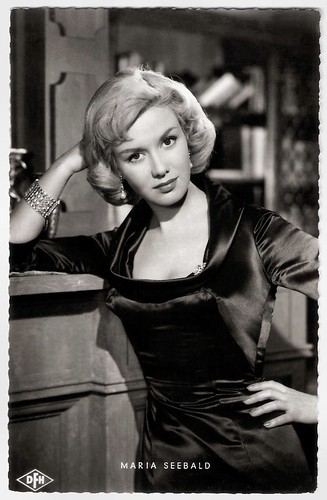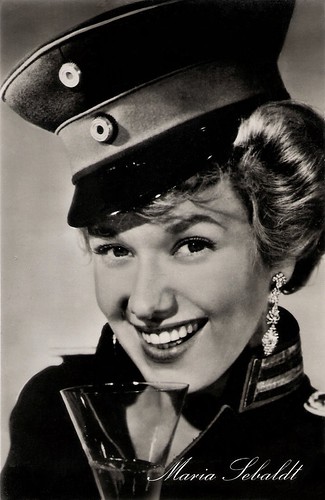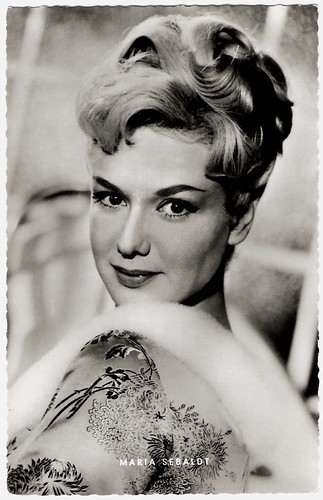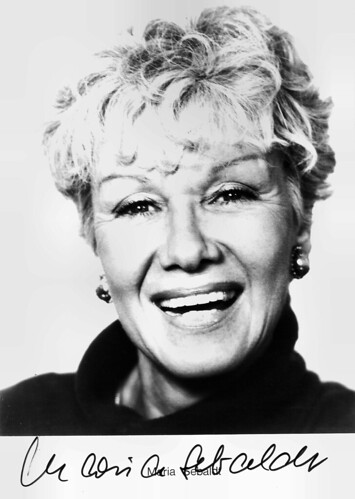Maria Sebaldt (1930) is a German actress who appeared in many lightweight entertainment films of the 1950 and 1960s. Her parts were often flirtatious and playful. Highlights were the comedies Der Hauptmann von Köpenick/The Captain from Köpenick (1956) and Die Zürcher Verlobung/The Zurich Engagement (1957), both directed by Helmut Käutner. Later she was very popular on TV.

German postcard by Kunst und Bild, Berlin-Charlottenburg, no. I 297. Photo: Kurt Ulrich-Film / Deutsche Film Hansa (DFH) / Wesel. Publicity still for Der Greifer/The Copper (Eugen York, 1958).
Maria Katharina Helene Sebaldt was born in 1930 in Berlin-Steglitz. Her father was a portrait painter and flute soloist, who worked after the war as the department head of Paramount film distribution.
From 1946 to 1949 Maria took private acting lessons from actress Anne Marie Asmus and studied at the Weimar Stanislawsky School. In 1947 she already made her stage debut in Maximilian Böttcher’s Krach im Hinterhaus. It was followed by numerous stage engagements in such cities as Sondershausen, Berlin and Munich.
Her film debut was a small part as a room maid in the farce So ein Affentheater/Monkey business (Erik Ode, 1953), followed by a part next to Rudolf Prack in the Heimatfilm Wenn am Sonntagabend die Dorfmusik spielt/Sunday Night when the village music plays (Rudolf Schündler, 1953). From then on she focused on film and television.
She appeared in musical films like the film operetta Der Zigeunerbaron/The Gypsy Baron (Arthur Maria Rabenalt, 1954), starring Paul Hörbiger, Der Zarewitsch/The Little Czar (Arthur Maria Rabenalt, 1954) and Tausend Sterne leuchten/A Thousand Stars Aglitter (Harald Philipp, 1959) starring Germaine Damar, but she also played in dramas such as Anastasia, die letzte Zarentochter/The Story of Anastasia (Falk Harnack, 1956) featuring Lilli Palmer. This film is based on the true story of a woman in Berlin who was pulled from the Landwehr Canal in 1920 and who later claimed to be Anastasia, the youngest daughter of Czar Nicholas II of Russia.
Sebaldt appeared with Heinz Rühmann in the funny Carl Zuckmayer adaptation Der Hauptmann von Köpenick/The Captain from Köpenick (Helmut Käutner, 1956). Ray Cooper at IMDb: “Heinz Rühmann excels in one of his most popular roles as ex-con who puts on the uniform of a Captain and fools the whole German army. Very funny, smart, beautifully realized, colorful comedy drama with great cast overshadowed by Rühmann's one-of-a-kind turn“.
Another highlight among Sebaldt’s films is the comedy Die Zürcher Verlobung/The Zurich Engagement (Helmut Käutner, 1957) with Lilo Pulver. At IMDb, Stefan Kahrs writes: “The film has dated much less badly than other romantic comedies from this era. Amongst other reasons is that the central characters are not meant to be perfect, not even perfect for each other, and this adds a touch of realism that is very refreshing. The cast is excellent, in both supporting and leading roles.”
Other comedies with Sebaldt are Vater, Mutter und neun Kinder/Father, Mother and nine Children (Erich Engels, 1958) with Heinz Erhardt, and the Peter Alexander vehicle Peter schießt den Vogel ab/Peter shoots the bird (Géza von Cziffra, 1959). Eddie Constantine was her co-star in the gangster parody Hoppla, jetzt kommt Eddie/ Hoopla, Now Comes Eddie (Werner Klingler, 1958).
She also had a small role in the literary adaptation Die Buddenbrooks (Alfred Weidenmann, 1959) based on the famous novel by Thomas Mann. She played the cunning gangster Virginia Peng in Nick Knattertons Abenteuer - Der Raub der Gloria Nylon/The Kidnapping of Miss Nylon (Hans Quest, 1959), the live-action version of Manfred Schmidt's popular comic series Nick Knatterton.

East-German postcard by VEB Progress Film-Vertrieb. Berlin, no. 321. Photo: Real-Film. Publicity still for Der Kaufmann von Köpenick/The Captain from Köpenick (Helmut Käutner, 1956).

German postcard by Kunst und Bild, Berlin-Charlottenburg, no. T 890. Photo: Arthur Grimm / Bavaria / Schorcht. Publicity still for Eine Frau die weiss wass sie will/Mother of Pearl (Arthur Maria Rabenalt, 1958).
In 1960, Maria Sebaldt reunited with Heinz Rühmann in the Father Brown mystery Das schwarze Schaf/The Black Sheep (Helmuth Ashley, 1960). She appeared in the operetta film Der Vogelhändler/The Bird Seller (Géza von Cziffra, 1962) next to Conny Froboess.
Jan Onderwater at IMDb: “The plot of the operetta was changed to fit into 90 minutes, but maybe also for the original being unacceptably corny; but it is all to no avail. Von Cziffra directed without imagination and spirit and he is hopelessly inadequate in using the Ultrascope format. The result is a dull film, not helped much by an average cast; Conny Froboess seems not at all to be comfortable with her part and Ruth Stephan and Rudolf Platte, both always good for comic interludes, are very disappointing; it is only Maria Sebaldt who sometimes brings some life into the film.“
She reunited with Peter Alexander for the Austrian comedy Charley's Tante/Charley's Aunt (Géza von Cziffra, 1963), an adaptation of the British farce Charley's Aunt by Brandon Thomas. The result was also disappointing.
Better was the exciting and cynical Euro-Western Pistoleros de Arizona/5.000 dollari sull'asso/Five Thousand Dollars on One Ace (Alfonso Balcázar, 1965). Ma-cortes at IMDb: “The film packs Western action, comical elements, thrills, shoot'em up, brawls, and results to be quite entertaining.”
Interesting was also the comedy …aber Jonny!/...But Johnny! (Alfred Weidenmann, 1973) with Horst Buchholz as a callboy.
On television, Sebaldt became popular with her part in the series Ich heirate eine Familie/I marry a family (1983-1986). Between 1986 and 1991, she played the worrying Hannelore Wichert in Die Wicherts von nebenan/The Wicherts next door, now a cult-series in Germany.
She also guest-starred in German series like Der Kommissar (1969, 1973), Derrick (1976, 1978, 1980, 1981), Der Alte/The Old Fox (1978, 1982), Tatort (1979) and Das Traumschiff/The Dream Ship (1991, 1993, 2003, 2006, 2010, 2014).
In France, she appeared in the TV Miniseries Toutes griffes dehors/Claws (Michel Boisrond, 1982) with Sophie Desmarets. More recently she appeared in the documentary Germaine Damar - Der tanzende Stern/Germaine Damar – The Dancing Star (Michael Wenk, 2011) in which she tells about her former colleague from Luxemburg. Sebaldt worked extensively for the radio and as a voice actress she was the German voice for foreign colleagues as Antonella Lualdi, Eva Marie Saint and Joanne Woodward.
From 1965 until his death in 2010 Maria Sebaldt was married with her Austrian-Swiss colleague Robert Freitag. In 1997, she published with Freitag’s first wife, the actress Maria Becker, the cookbook Essen und trinken und fröhlich sein (Eat and drink and be merry). Maria Sebaldt has a daughter, sculptor Katharina Freitag (1967) and a grandson, Julian, and she lives in Grünwald near Munich.

German postcard by Franz Josef Rüdel, Filmpostkartenverlag, Hamburg. Photo: Hilde Zemann, München.
Trailer for Hoppla, jetzt kommt Eddie/ Hoopla, Now Comes Eddie (1958). Source: Film- und Fernsehjuwelen (YouTube).
Trailer for Nick Knattertons Abenteuer - Der Raub der Gloria Nylon/The Kidnapping of Miss Nylon (1959). Source: Film- und Fernsehjuwelen (YouTube).
Sources: Stephanie D’heil (Steffi-Line- German), Jan Onderwater (IMDb), Ma-cortes (IMDb), Stefan Kahrs (IMDb), Ray Cooper (IMDb), Wikipedia (German and English) and IMDb.

German postcard by Kunst und Bild, Berlin-Charlottenburg, no. I 297. Photo: Kurt Ulrich-Film / Deutsche Film Hansa (DFH) / Wesel. Publicity still for Der Greifer/The Copper (Eugen York, 1958).
A touch of realism that is very refreshing
Maria Katharina Helene Sebaldt was born in 1930 in Berlin-Steglitz. Her father was a portrait painter and flute soloist, who worked after the war as the department head of Paramount film distribution.
From 1946 to 1949 Maria took private acting lessons from actress Anne Marie Asmus and studied at the Weimar Stanislawsky School. In 1947 she already made her stage debut in Maximilian Böttcher’s Krach im Hinterhaus. It was followed by numerous stage engagements in such cities as Sondershausen, Berlin and Munich.
Her film debut was a small part as a room maid in the farce So ein Affentheater/Monkey business (Erik Ode, 1953), followed by a part next to Rudolf Prack in the Heimatfilm Wenn am Sonntagabend die Dorfmusik spielt/Sunday Night when the village music plays (Rudolf Schündler, 1953). From then on she focused on film and television.
She appeared in musical films like the film operetta Der Zigeunerbaron/The Gypsy Baron (Arthur Maria Rabenalt, 1954), starring Paul Hörbiger, Der Zarewitsch/The Little Czar (Arthur Maria Rabenalt, 1954) and Tausend Sterne leuchten/A Thousand Stars Aglitter (Harald Philipp, 1959) starring Germaine Damar, but she also played in dramas such as Anastasia, die letzte Zarentochter/The Story of Anastasia (Falk Harnack, 1956) featuring Lilli Palmer. This film is based on the true story of a woman in Berlin who was pulled from the Landwehr Canal in 1920 and who later claimed to be Anastasia, the youngest daughter of Czar Nicholas II of Russia.
Sebaldt appeared with Heinz Rühmann in the funny Carl Zuckmayer adaptation Der Hauptmann von Köpenick/The Captain from Köpenick (Helmut Käutner, 1956). Ray Cooper at IMDb: “Heinz Rühmann excels in one of his most popular roles as ex-con who puts on the uniform of a Captain and fools the whole German army. Very funny, smart, beautifully realized, colorful comedy drama with great cast overshadowed by Rühmann's one-of-a-kind turn“.
Another highlight among Sebaldt’s films is the comedy Die Zürcher Verlobung/The Zurich Engagement (Helmut Käutner, 1957) with Lilo Pulver. At IMDb, Stefan Kahrs writes: “The film has dated much less badly than other romantic comedies from this era. Amongst other reasons is that the central characters are not meant to be perfect, not even perfect for each other, and this adds a touch of realism that is very refreshing. The cast is excellent, in both supporting and leading roles.”
Other comedies with Sebaldt are Vater, Mutter und neun Kinder/Father, Mother and nine Children (Erich Engels, 1958) with Heinz Erhardt, and the Peter Alexander vehicle Peter schießt den Vogel ab/Peter shoots the bird (Géza von Cziffra, 1959). Eddie Constantine was her co-star in the gangster parody Hoppla, jetzt kommt Eddie/ Hoopla, Now Comes Eddie (Werner Klingler, 1958).
She also had a small role in the literary adaptation Die Buddenbrooks (Alfred Weidenmann, 1959) based on the famous novel by Thomas Mann. She played the cunning gangster Virginia Peng in Nick Knattertons Abenteuer - Der Raub der Gloria Nylon/The Kidnapping of Miss Nylon (Hans Quest, 1959), the live-action version of Manfred Schmidt's popular comic series Nick Knatterton.

East-German postcard by VEB Progress Film-Vertrieb. Berlin, no. 321. Photo: Real-Film. Publicity still for Der Kaufmann von Köpenick/The Captain from Köpenick (Helmut Käutner, 1956).

German postcard by Kunst und Bild, Berlin-Charlottenburg, no. T 890. Photo: Arthur Grimm / Bavaria / Schorcht. Publicity still for Eine Frau die weiss wass sie will/Mother of Pearl (Arthur Maria Rabenalt, 1958).
Western action, comical elements, thrills, shoot'em up, brawls
In 1960, Maria Sebaldt reunited with Heinz Rühmann in the Father Brown mystery Das schwarze Schaf/The Black Sheep (Helmuth Ashley, 1960). She appeared in the operetta film Der Vogelhändler/The Bird Seller (Géza von Cziffra, 1962) next to Conny Froboess.
Jan Onderwater at IMDb: “The plot of the operetta was changed to fit into 90 minutes, but maybe also for the original being unacceptably corny; but it is all to no avail. Von Cziffra directed without imagination and spirit and he is hopelessly inadequate in using the Ultrascope format. The result is a dull film, not helped much by an average cast; Conny Froboess seems not at all to be comfortable with her part and Ruth Stephan and Rudolf Platte, both always good for comic interludes, are very disappointing; it is only Maria Sebaldt who sometimes brings some life into the film.“
She reunited with Peter Alexander for the Austrian comedy Charley's Tante/Charley's Aunt (Géza von Cziffra, 1963), an adaptation of the British farce Charley's Aunt by Brandon Thomas. The result was also disappointing.
Better was the exciting and cynical Euro-Western Pistoleros de Arizona/5.000 dollari sull'asso/Five Thousand Dollars on One Ace (Alfonso Balcázar, 1965). Ma-cortes at IMDb: “The film packs Western action, comical elements, thrills, shoot'em up, brawls, and results to be quite entertaining.”
Interesting was also the comedy …aber Jonny!/...But Johnny! (Alfred Weidenmann, 1973) with Horst Buchholz as a callboy.
On television, Sebaldt became popular with her part in the series Ich heirate eine Familie/I marry a family (1983-1986). Between 1986 and 1991, she played the worrying Hannelore Wichert in Die Wicherts von nebenan/The Wicherts next door, now a cult-series in Germany.
She also guest-starred in German series like Der Kommissar (1969, 1973), Derrick (1976, 1978, 1980, 1981), Der Alte/The Old Fox (1978, 1982), Tatort (1979) and Das Traumschiff/The Dream Ship (1991, 1993, 2003, 2006, 2010, 2014).
In France, she appeared in the TV Miniseries Toutes griffes dehors/Claws (Michel Boisrond, 1982) with Sophie Desmarets. More recently she appeared in the documentary Germaine Damar - Der tanzende Stern/Germaine Damar – The Dancing Star (Michael Wenk, 2011) in which she tells about her former colleague from Luxemburg. Sebaldt worked extensively for the radio and as a voice actress she was the German voice for foreign colleagues as Antonella Lualdi, Eva Marie Saint and Joanne Woodward.
From 1965 until his death in 2010 Maria Sebaldt was married with her Austrian-Swiss colleague Robert Freitag. In 1997, she published with Freitag’s first wife, the actress Maria Becker, the cookbook Essen und trinken und fröhlich sein (Eat and drink and be merry). Maria Sebaldt has a daughter, sculptor Katharina Freitag (1967) and a grandson, Julian, and she lives in Grünwald near Munich.

German postcard by Franz Josef Rüdel, Filmpostkartenverlag, Hamburg. Photo: Hilde Zemann, München.
Trailer for Hoppla, jetzt kommt Eddie/ Hoopla, Now Comes Eddie (1958). Source: Film- und Fernsehjuwelen (YouTube).
Trailer for Nick Knattertons Abenteuer - Der Raub der Gloria Nylon/The Kidnapping of Miss Nylon (1959). Source: Film- und Fernsehjuwelen (YouTube).
Sources: Stephanie D’heil (Steffi-Line- German), Jan Onderwater (IMDb), Ma-cortes (IMDb), Stefan Kahrs (IMDb), Ray Cooper (IMDb), Wikipedia (German and English) and IMDb.
No comments:
Post a Comment